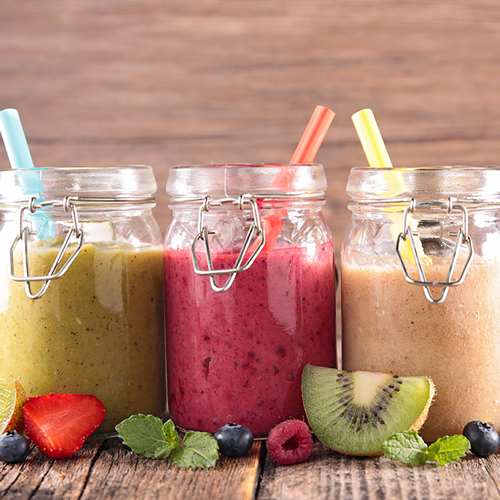
Get Schooled in Smoothies

Yes, the smoothie trend is worldwide, Instagrammable, and generally a yummy way to consume your daily produce. However, they aren't all health and happiness. The biggest myth we want to shatter is that these smoothies are completely healthy. Yes, they comprise a combination of healthy foods, but they are actually filled with sugar because of their produce content. (Yes, fruits and vegetables contain sugar.) Ergo, the tastier the smoothie, the more naturally-occurring sugars in the fruit composition of the smoothie. Truth be told, you can have a green juice or smoothie or smoothie bowl, and it would contain similar amounts of sugar to that of a juice or soda drink.
At the end of the day, drinks with over 20 grams of sugar per serving will shoot up your insulin. (Insulin is a hormone released by the pancreas to transport carbs from your food to your tissues, which is then stored for energy use.) If you've ever had a smoothie in the morning and feel hungry afterwards, that's a sign of energy crash. The initial rush of sugars (again, what the body uses for energy) will eventually leave you irritable and susceptible to cravings because of the blood sugar spike.
Boost your smoothies

If you are going to go the smoothie route as part of your daily food regimen, we recommend incorporating some "boosts" that will make your smoothie healthier for you, for a happier you!
- Dark, leafy greens. A vegetable-dominant smoothie is lower in sugar content, and higher in essential vitamin content. Greens like spinach, kale, Chinese cabbage, and other dark-leaf variants are high in Vitamin K (for bone health, for heart health) and Vitamin A (for vision and immune health).
- Leafy herbs, like basil, mint, parsley are microgreens that are packed with immune-boosting properties. These are added in smaller portions than the dark leafy greens.
- Berries or berry powder. Berries are low-sugar fruits, so adding them to your smoothie will help suppress cravings for a longer period of time, as well as add antioxidant and anti-aging benefits. Check out the Arctic Power sachet in your April box!
- Low-sugar fruits and veggies. Apples, pears, celery, cucumbers add fiber and water content to your smoothie.
- Protein. Adding kefir, Greek yogurt, chilled tofu, peanut butter or another type of nut butter will help bulk up the protein content of your smoothie, keeping you fuller. (When taken after a workout, the proteins are beneficial in burning calories and building up muscle.)
- Cacao nibs. Cacao is said to help in managing cholesterol, lowering blood pressure and in making blood circulation more efficient. It also helps release the hormones serotonin and endorphins, which keep are mood boosters that help battle stress. Check out the Cacao Nibs from Natural Health in your April box!
- Seeds. Flax seeds, hemp seeds and chai seeds make great boosters and are packed with omega-3 fatty acids that are essential for overall heart health and also for heightened immunity.
- Natural protein powders. These are available in health food stores and are concentrated forms of protein. Whey protein, pea protein, soy protein and rice protein powders add bulk, amino acids and antioxidants to your smoothies.

If you want to use your smoothie as a meal replacement, the universal ratio of fruits to veggies is 1 cup of fruit to 2 cups of greens. If you add 1/4 a cup of cooked grains (like ground oatmeal), or 2 tablespoons of any of the suggested proteins, fat, and fibers above, you will feel fuller and more satisfied. It's recommended that you also stick to healthy, protein and iron-rich snacks in between meals so that you don't give in to cravings. Happy smoothie-ing!

Leave a comment